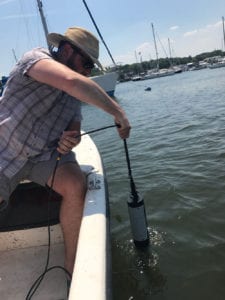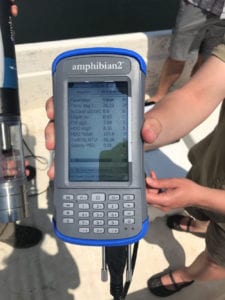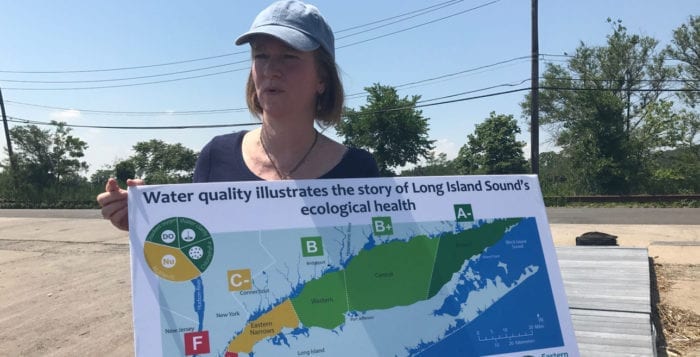There’s a team collaboration happening across Long Island to ensure the Long Island Sound’s water is as healthy as possible.
Save the Sound, a nonprofit organization based out of Connecticut, is working with local groups and volunteers to create a water quality report card for the Sound’s bays and harbors, in an effort to increase available data for residents to have access to information on the health of the Sound.
Monitoring of the open Sound, the areas of the water body beyond bays and harbors, in the last decade has revealed the increasing presence of nitrogen pollution — which leads to algae blooms, red tides, loss of tidal marshes and fish die-offs — and the incremental improvements brought about by wastewater treatment plant upgrades. But researchers have acknowledged that results found in the open Sound may not reflect conditions in the bays and harbors, where a large part of the public comes in contact with the Sound.

In May, Save the Sound started conducting the Unified Water Study in 24 sites across the Sound, and participants will be testing the water twice a month through October, looking at dissolved oxygen levels, temperature, dissolved salt levels, water quality and more.
Organizers gathered at Huntington Harbor in Halestie to conduct a test Tuesday, June 13, and explained why the report card is so important for the future of bays and harbors across Long Island.
“The Long Island Sound Funders Collaborative funded a report card for the sound, with the first one coming out in 2015, and through the report card process we realized that most of the data we had collected to talk about water quality and the health of the sound was for the open Sound,” Tracy Brown, director of Save the Sound said at the harbor. “And when we published the report card and showed the scores of water quality but we didn’t go into all the bays and harbors the public said, ‘well how about my harbor, how about my cove?’ The bays, harbors and coves are their own unique ecosystems. So we realized we had a data gap.”
Brown said certain groups have been doing their own studies in smaller areas but nothing uniform to have a comparative level. The report card focuses on the ecological health, not bacteria levels and risk of contamination for humans entering the water, but rather the creatures living in the water 24/7.
“The pollutant of concern is nitrogen,” Brown said. “This study was designed to get into all 116 little bays, harbors and coves that encircle the sound, and our goal is to get into each of them taking the exact same measurements for an assessment to say which of the bays and harbors are not handling the nutrient input well, which ones are really suffering from nutrient pollution and then we can direct conservation resources.”
Brown said one of the leading causes of increased nitrogen is contamination from the septic systems, as urine has high levels of nitrogen. She said efforts like Suffolk County Executive Steve Bellone’s (D) initiatives to improve groundwater and limit nitrogen pollution are a step in the right direction.
“Nitrogen pollution has been identified as the single greatest threat to water quality, but for the first time in decades, we have a historic opportunity to turn the tide in our effort to reclaim our waters,” Bellone said in a statement when announcing countywide nitrogen-reducing initiatives for homeowners.
Brown reiterated some of the dangers of high levels of nitrogen.
“High levels of nitrogen feed growth, creating algal blooms, and when the algal blooms die they suck the oxygen out of the water in that decay process so you create these low oxygen zones,” she said.
Low oxygen levels mean finfish and shellfish can’t live in the area, and high nitrogen levels also lead to the destruction of coastal wetlands, which not only serve as a habitat for animals but also are a defense for homes from destructive storms. Brown also said high nitrogen levels are being linked to high acidification levels, which prevent shellfish from forming their shells and reduce the population’s ability to reproduce.
About a year ago Peter Janow, a Cold Spring Harbor resident, got in touch with Save the Sound, after hearing about their efforts, and extended an offer to help if they needed any hands for the Huntington and Northport bay areas.

“Once they created the Uniform Water Study they got in contact with me and asked if I could help out and I said ‘absolutely brother,’” Janow said of how he first got involved. He eventually ended up joining more volunteers to work on the area together. He said he was motivated to get involved to both make a difference and help become a stronger part of his community.
“Most folks, especially on Long Island we’re surrounded by gorgeous scenes, the harbors, all the water sports,” Janow said. “We [the volunteers] share in the duties, and the role is covering the greater Huntington and Northport complexes including Lloyd Harbor, Huntington Harbor, Centerport Harbor, Northport Harbor and Duck Island Harbor, and each one of those areas has its own qualities. We have a total of 25 specific locations we’re testing water samples from.”
Janow said he and the others divide the areas up into two different days, spending about three hours each day testing water samples.
The combined efforts are for the benefit of all Long Islanders, and residents can help without getting on the water themselves.
“We really hope the public will see the significance,” Brown said. “If you want a better grade, you need to take care of your wastewater, and reduce your lawn fertilizer. The science community has identified nitrogen as enemy number one to the Long Island Sound, and the philanthropic community said, ‘what can we do,’ and then they reached out to regional groups to execute their vision, and then we’ve reached out to local groups for help. That’s what’s so interesting about this study — the collaboration.”
The collaborative effort is far from over. Brown said there is still a need for more volunteers to cover areas east of Huntington, including areas in the towns of Smithtown and Brookhaven, especially near the Nissequogue River and Port Jefferson Harbor.
This effort travels all the way to Connecticut, and one science teacher at a town in Dover took the initiative to volunteer himself and his Advanced Placement students to help contribute.
“One of the things that makes it possible for groups to organize to participate in this study even if they’re not already a group is that we provide the equipment, we provide the training, we provide the standard operating procedures and Save the Sound is available to help them get off the ground and make sure they succeed,” Brown said. “If we’re going to reach all 116 systems around the Sound that we want to reach, we’re going to need more groups. We’re going to need new groups that don’t exist yet to organize around the study and ask if anyone is in their bay or harbor yet.”
Anyone interested in getting involved with Save the Sound should reach out to Peter Linderoth, the Save the Sound water quality manager at [email protected].





